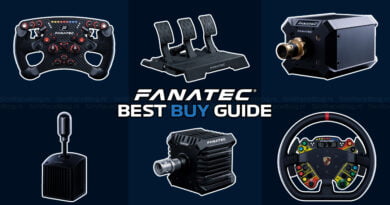The Ultimate Beginner’s Guide to Simracing

Sim racing is an exciting and accessible way to experience motorsports without having to drive on a real track. Over the past few years, sim racing has evolved from simple racing games into hyper-realistic simulations used even by professional drivers. With the right hardware and software, you can create a racing experience that closely mirrors reality, allowing both beginners and experienced racers to continue improving their skills.
But where do you start? What equipment do you need, and which software best suits your goals? In this guide, we’ll take you step by step into the world of sim racing. We’ll cover essential hardware, popular simulations, driving techniques, and even competitive racing in online leagues. You’ll also learn how to improve your performance and avoid common beginner mistakes.
Whether you’re a hobbyist racing for fun or have serious ambitions to compete, this guide will help you make the right choices and build a solid foundation. From setting up your first sim rig to advanced techniques like tire wear and fuel management, this guide provides everything you need to confidently dive into sim racing.
Table of contents
- Introduction to Sim Racing
- What is sim racing?
- Why sim race?
- The evolution of sim racing
- Essential Equipment
- Hardware: Steering wheels, pedals, and shifters
- Simrigs and cockpits
- Monitors vs. VR
- PC vs. Console
- Software and Simulations
- Overview of popular simulations (iRacing, Assetto Corsa, ACC, rFactor 2, etc.)
- Settings and optimization
- Force Feedback and telemetry
- Getting Started with Sim Racing
- Choosing your first setup
- Basic driving techniques and racing lines
- Practicing and improving
- Multiplayer and Competitive Racing
- Online racing and esports competitions
- Safety and sportsmanship
- Licenses and rankings
- Advanced Techniques
- Car setup and tuning
- Tire wear and fuel management
- Advanced driving techniques
- Accessories and Extras
- H-shifters and handbrakes
- Motion platforms and buttkickers
- Streaming and content creation
- Common Beginner Mistakes
- Upgrading too quickly
- Underestimating settings and training
- Unrealistic expectations
- Useful Resources and Communities
- Forums and Discord groups
- YouTube Channels and Tutorials
- Websites for Setup Guides and Data Analysis
- Closing Words
1. Introduction to Simracing
What is Sim Racing?
Sim racing, short for simulator racing, is the digital equivalent of real-world motorsports. With realistic physics and highly detailed car and track models, sim racing delivers an authentic racing experience. Unlike arcade racing games, sim racing focuses on precision, technique, and realism.
Why Sim Race?
Sim racing isn’t just a fun hobby—it’s also a serious sport. Many professional drivers use simulators for training, and sim racers can develop into competitive drivers without the high costs of real-world racing. Additionally, sim racing offers a global community where you can challenge yourself against other racers.
The Evolution of Simracing
Sim racing has seen massive growth in recent years. While older titles like Grand Prix Legends and GTR 2 set the standard in the past, today’s simulations—such as iRacing and Assetto Corsa Competizione—offer an unparalleled level of realism. Thanks to the combination of advanced hardware and highly realistic software, sim racing is now more accessible than ever.
2. Essential Equipment
Hardware: Steering Wheels, Pedals, and Shifters
One of the most important investments in sim racing is a steering wheel and pedal set. There are various brands and price ranges available, from entry-level models like the Logitech G923 to high-end direct drive systems from Fanatec, Simucube, and Moza Racing.
Pedals with load cell technology provide a more realistic braking feel, while optional shifters and handbrakes enhance immersion, especially in rally and drift racing.
Simrigs and Cockpits
A stable sim rig or cockpit prevents unwanted movement of your wheel and pedals. There are simple foldable stands, but also robust aluminum profiles that can be expanded with accessories like monitor mounts and motion platforms.
Monitors vs. VR
A single monitor is enough to get started, but many sim racers prefer ultrawide or triple-screen setups for a wider field of view. VR headsets like the Pimax VR, HP Reverb G2, and Meta Quest 3 offer an even more immersive experience but require a powerful PC.
PC vs. Console
PCs offer the most options in terms of simulations and hardware support. Consoles like PlayStation and Xbox have some limitations but still support popular titles such as Assetto Corsa, Assetto Corsa Competizione, Gran Turismo, and Forza Motorsport. The choice depends on your budget and preferences.
3. Software and Simulations
Overview of Popular Simulations
There are many different sim racing games available, each with its own focus and community:
- iRacing – Structured online races and realistic physics.
- Assetto Corsa (AC) – Highly mod-friendly with a wide range of cars and tracks.
- Assetto Corsa Competizione (ACC) – Official GT3 and GT4 racing simulator.
- rFactor 2 – Realistic physics and advanced tire simulation.
- RaceRoom – Free to play with premium content available.
Settings and Optimization
To get the most out of your sim, it’s important to fine-tune your settings. This includes adjusting graphics for better performance and optimizing force feedback for a more realistic steering feel.
Force Feedback and Telemetry
Well-configured force feedback (FFB) helps you feel grip, understeer, and bumps on the track. Telemetry tools like MoTeC and VRS assist in analyzing driving behavior and vehicle setups.
4. Getting Started with Simracing
Choosing Your First Setup
Starting with simracing doesn’t have to be expensive. A simple setup with a Logitech G29 or Thrustmaster T300 and a sturdy desk can be enough. Gradually invest in upgrades as your experience grows.
Basic Driving Techniques and Racing Lines
Mastering basics like braking points, apexes, and throttle control is essential. Simracers can practice these techniques by watching circuit guides and analyzing ghost laps from faster drivers.
Practice and Improvement
Regular practice is the key to improvement. Use time trials, AI races, and online competitions to refine your skills. Analyze your replays to identify mistakes and keep learning by experimenting with different setups and driving styles.
5. Multiplayer and Competitive Racing
Online Racing and Esports Competitions
Once you’ve mastered the basics, it’s time to race online. Platforms like iRacing, LFM (Low Fuel Motorsport), and GT Sport offer structured competitions with opponents of similar skill levels. Additionally, esports tournaments and leagues organize races for both beginners and professionals.
Safety and Sportsmanship
To keep online racing fun and fair, there are rules and etiquette:
- Stay on your line: Unpredictable driving leads to crashes.
- Use your mirrors and radar: Be aware of other cars to avoid collisions.
- Avoid dive bombs: Try to overtake in a controlled manner.
- Give back positions if you make a mistake: This is appreciated and helps your reputation.
Licenses and Rankings
Many simulations use a licensing and rating system:
- iRacing uses Safety Rating (SR) and iRating (IR) to measure your cleanliness and skill, respectively.
- ACC and Gran Turismo Sport have similar systems where you’re rated based on consistency and sportsmanship.
By racing clean and avoiding incidents, you can rise in the rankings and gain access to more competitive races.
6. Advanced Techniques
Car Setup and Tuning
A well-tuned car can make a big difference in performance. Key adjustments include:
- Tire pressure and temperature: Make sure your tires are working within the optimal range.
- Suspension and damping: Adjust to your driving style and the circuit.
- Aero settings: Higher downforce improves cornering performance but lowers top speed.
Tire Wear and Fuel Management
In longer races, strategy and consistency are key:
- Manage your tires: Avoid unnecessary sliding and brake locking to reduce wear.
- Fuel saving: Lift & Coast techniques can help reduce the number of pit stops.
Advanced Driving Techniques
There are several techniques that can help you achieve faster lap times:
- Trail braking: Brake while turning to maintain more grip on the front tires.
- Throttle control: Apply gas carefully when exiting a corner to prevent wheel spin.
- Racing in traffic: Learn how to use the slipstream and choose defensive lines without losing too much speed.
By mastering and applying these techniques, you can become competitive at any level of simracing.
7. Accessories and Extras
H-shifters and Handbrakes
For rally and drift simulations, an H-shifter and handbrake are valuable additions. They increase immersion and give you more control over the car.
Motion Platforms and ButtKickers
Motion platforms simulate the forces of the car, allowing you to feel movements like G-forces and road imperfections. ButtKickers provide haptic feedback when making contact with the road, during collisions, and gear shifts.
Streaming and Content Creation
Many sim racers share their races via livestreams or YouTube. With OBS Studio and a webcam, you can easily get started with streaming and content creation.
8. Common Beginner Mistakes
Upgrading Too Quickly
Many beginners invest directly in expensive hardware without developing their skills first. Start with an entry-level model and only upgrade when you truly feel that your hardware is limiting you.
Underrating Settings and Training
Simracing is challenging and requires practice. It’s important to spend time fine-tuning your settings and training regularly to improve.
Unrealistic Expectations
Simracing isn’t the same as arcade racing. It takes patience and dedication to get better and compete at a competitive level.
9. Useful Resources and Communities
Forums and Discord Groups
- SimRaceBlog Discord
- iRacing Forums
- OverTake.gg (Voormalig RaceDepartment)
- Sim Racing Reddit
- Low Fuel Motorsport
YouTube Channels and Tutorials
- Chris Haye (simracing reviews en tips)
- Driver61 (race- en simracingtechnieken)
- James Baldwin (technische analyses en on-board coaching)
Websites for Setup Guides and Data Analysis
- VRS (Virtual Racing School)
- Coach Dave Academy
- iRacing Setup Sync
10. Closing Words
Sim racing offers a fantastic way to experience motorsports in a realistic and accessible way. Whether you’re starting with a simple setup or investing in an advanced system, there’s always room to improve your skills and have fun. With the right approach, training, and dedication, you can develop into a fast and consistent sim racer.
In this guide, we’ve covered the key aspects of sim racing—from basic equipment and software to advanced techniques and competitive racing. By applying the tips and strategies from this article, you can build a solid foundation and gradually improve your performance.
Remember, sim racing isn’t just about speed; it’s also about discipline, consistency, and respect for other racers. Keep practicing, experiment with your settings, and most importantly, enjoy the journey. Good luck and have fun on the virtual track!
Do you want to stay informed about SimRaceBlog content, news, announcements and (future) give-aways? Follow us on Instagram @simraceblognl and/or our Discord channel.



